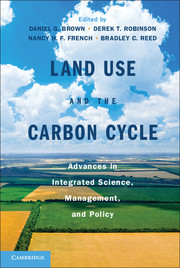Book contents
- Frontmatter
- Contents
- Chapter Authors and Affiliations
- Acknowledgments
- Acronyms
- Part I Introduction
- Part II Measurement and Modeling
- Part III Integrated Science and Research Applications
- 9 Carbon Emissions from Land-Use Change: Model Estimates Using Three Different Data Sets
- 10 A System to Integrate Multiscaled Data Sources for Improving Terrestrial Carbon Balance Estimates
- 11 Simulated Biogeochemical Impacts of Historical Land-Use Changes in the U.S. Great Plains from 1870 to 2003
- 12 Carbon Signatures of Development Patterns along a Gradient of Urbanization
- Part IV Land Policy, Management, and the Carbon Cycle
- Part V Synthesis and Future Directions
- Index
- Plate Section
- References
10 - A System to Integrate Multiscaled Data Sources for Improving Terrestrial Carbon Balance Estimates
Published online by Cambridge University Press: 05 February 2013
- Frontmatter
- Contents
- Chapter Authors and Affiliations
- Acknowledgments
- Acronyms
- Part I Introduction
- Part II Measurement and Modeling
- Part III Integrated Science and Research Applications
- 9 Carbon Emissions from Land-Use Change: Model Estimates Using Three Different Data Sets
- 10 A System to Integrate Multiscaled Data Sources for Improving Terrestrial Carbon Balance Estimates
- 11 Simulated Biogeochemical Impacts of Historical Land-Use Changes in the U.S. Great Plains from 1870 to 2003
- 12 Carbon Signatures of Development Patterns along a Gradient of Urbanization
- Part IV Land Policy, Management, and the Carbon Cycle
- Part V Synthesis and Future Directions
- Index
- Plate Section
- References
Summary
Introduction
Motivation and Applications
Between 6 and 17 percent of the total annual anthropogenic carbon dioxide (CO2) emissions come from terrestrial ecosystem degradation or loss, making up the second-largest source of greenhouse gases (GHGs) in the world after fossil fuel emissions (van der Werf et al. 2009). Because of this, many policy makers have focused on reducing emissions from terrestrial ecosystems as one way to help mitigate climate change. The estimation of carbon (C) stocks and fluxes that result from land-use change and ecosystem management is critical for policies that attempt to incentivize increased ecosystem sequestration or reduced emissions of GHGs. Furthermore, estimates of potential sequestration rates in optimal conditions, as well as anticipated changes in growth rates due to climate change, are important in understanding how emissions reductions or sequestration fit within a broader understanding of terrestrial C exchange.
For more than a decade, decision makers have debated how to best include terrestrial ecosystems in policy approaches to mitigate and adapt to climate change. Recently, these discussions have focused on reducing emissions from deforestation or ecosystem degradation (REDD) at a country scale (see Chapters 8, 17, and 20 for more information on REDD). A REDD policy framework therefore requires credible estimates of the state of ecosystem C stocks and fluxes at a country scale as well as some understanding of how ecosystems have changed in the past and might change in the future at this scale. As policy makers in the international arena struggle to craft national REDD policies, the voluntary C market has rapidly evolved to fill the void left by the absence of international climate-change policy. The voluntary C offset market relies on a suite of different C offset standards (Climate, Community, and Biodiversity Alliance [CCBA] 2008; Verified Carbon Standard [VCS] 2012; Climate Action Reserve [CAR] 2010) that provide guidance on how to monitor, report, and verify C sequestration activities at much smaller scales (e.g., project level vs. country scale). Given the state of REDD policy and the voluntary C market, the purpose of this chapter is to explore a technical approach that can be used to generate credible estimates of C stocks and fluxes and to constrain the claimed benefits of C projects or policies at multiple scales.
- Type
- Chapter
- Information
- Land Use and the Carbon CycleAdvances in Integrated Science, Management, and Policy, pp. 259 - 286Publisher: Cambridge University PressPrint publication year: 2013
References
- 1
- Cited by



